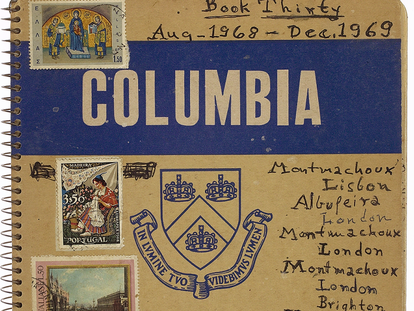When Patricia Highsmith died in 1995, Daniel Keel, whom she had appointed as literary executor, called her editor, Anna Von Planta, to enter the writer's fortress-house in Italian Switzerland together.
They were looking for unpublished material with which to expand the canon of one of the great American storytellers of the twentieth century.
They were also looking for his personal notes.
As in one of their stories, in which crime awaits under the gleaming appearance of normality, they were found hidden in a closet, behind perfectly ironed sheets.
More information
Patricia Highsmith's Big Lie
There were more than 8,000 pages full of letters, interspersed with drawings and photographs, distributed among 18 newspapers and 38 notebooks.
A quarter of a century later, a part of that material sees the light in the 999 pages of the book
Patricia Highsmith.
Her Diaries and Notebooks.
1941-1995
(Liveright; in May it is scheduled to be published in Anagrama).
It has been one of the literary events of the year in the United States, which began with the commemoration of the centennial of the birth in 1921 in Fort Worth (Texas) of the author of
The Talent of Mr. Ripley.
The set allows one to peer into the two existential motivations, writing and sex, of one of the most impenetrable authors of modern literature, world champion of misanthropy.
In the newspapers, Highsmith records his social life, his affairs with dozens of women, the endless succession of martinis and hangovers, his travels, his flirtations with depression, and the editorial and film milestones of a successful career. In the
cahiers
(notebooks), writes down thoughts on religion, love, food, politics and her teeth, settling accounts with herself and sharp literary reflections, around her work as a writer and her passion as a reader.
Also, as a good diarist, she develops theories about the meaning and purpose of journaling.
And history?
Usually it passes by: on December 7, 1941, after the phrase "Japan declares war on the United States," this one follows: "Miserable in class until I spoke to Helen at 1:30."
And in May 1968 he writes that "the worst thing is the interruption of the postal service."
Notes on writing from Patricia Highsmith's 1950 notebook, kept in Bern (Switzerland) Simon Schmid (Swiss National Library)
Highsmith's papers have been kept in Bern since the Swiss Literary Archive (Schweizerisches Literaturarchiv, SLA) bought them in the 1990s. They were accessible to researchers and have entertained Highsmith's leading biographers for decades, reproducing them in parts. “Notebooks have a greater literary ambition than newspapers. But together they form a unique emotional and intellectual autobiography ", says in a telephone conversation Ulrich Weber, archivist of the SLA, who regrets that the portions in which the writer wrote down" sketches of ideas have been left out of the recently published book, whose selection he appreciates. , stories and novels ”. "I hope that one day the full material will be published," he adds.
The editing of these papers has been the half-life endeavor of Anna Von Planta, who that day accompanied the executor to the Highsmith house in the canton of Ticino and works for Diogenes, the Swiss publishing house that took over the international rights to his works in the early eighties, when it was much more appreciated in Europe than in the United States. His handwriting had to be deciphered first, and that took several years. She wrote with her right hand and drew with her left (she was a “reformed left-handed,” according to Von Planta).
The transcript was collated by a friend of Highsmith's from school, Gloria Kate Kingsley Skattebol (who died in 2015), to whom the selection work was once assigned, as a 1950 journal entry suggests. She is dedicated to her. the book, together with David Keel, founder of Diogenes, who died in 2011. Kingsley was also commissioned to send the Columbia University ring notebooks from New York: they were the novelist's favorites and she continued to use them after leaving the United States at age 32 to live in the UK and in various places in France and Switzerland. That the set, whose publication was authorized by the novelist with precise instructions to Keel, survived the many changes of a wandering existence suggests that she considered it the endeavor of literally a lifetime.
Cover of Notebook 30, by Patricia Highsmith, with annotations from 1968 and 1969, kept in the Archives of Swiss Literature in Bern Simon Schmid (Swiss National Library)
The texts, written in English, French and German and a bit of Italian and Spanish, make up a material that in a way humanizes the image of Tom Ripley's mother, without sparing any lurid detail, from anti-Semitism to misogyny or racism, although, recalls Weber, the editors have chosen to leave out the most extreme opinions.
"The catalog of their hatreds was impressive for its diversity: Latinos, Blacks, Koreans, Indians, Native Americans, Portuguese, Mexicans and Catholics, among others," writes Richard Bradford in
Devils, Lusts and Strange Desires
(Demons, lusts and strange desires, Bloomsbury, 2021), biography that appeared in January, in which he also dwells on his anti-Semitism, which Von Planta defines in the prologue as a "mystery", if one takes into account the "many Jews who were among his friends, lovers and favorite artists. " In a telephone interview with this newspaper, Bradford explains that those opinions, which "became radicalized with age," come from "interviews and conversations held with people around him, in the private sphere, and that he never transferred them to his work. ”. "She knew she was a very nasty alcoholic," sums up Weber.
"I find the parallel with Ripley interesting," adds the biographer. “He lived a double life, and keeping up appearances led him to commit murder. I think that she, who was not a murderer, also had a double existence, that of her novels and that of her diaries ”. She loved, yes, animals, especially cats and snails (one of her most famous anecdotes tells that when she moved from the UK to France she crossed the border with some of her favorites under her bra).
Although there are earlier entries, the selection of Von Planta, who worked with Highsmith from 1984, begins at the age of twenty, when she was a poor Texan student at Barnard's New York University, entering the circle of artists and Lesbian writers in Greenwich Village, laments the news of the death of James Joyce and flagellates herself more than necessary: “Too long has passed, and I have done too little. I should be more creative and original at my age ”, he writes a few days after his 20th birthday. He enjoys the joys of being young in the big city - movies, records and exhibitions, cocktails, older married women or clothes - he fights with his mother, whose relationship could be really cruel (and understandably: It begins when she is pregnant, tried to abort taking turpentine,and ends with the daughter missing the mother's funeral) and indulges in love affairs with that passion followed by detachment which in her case was not just a matter of age. “I lost two months with Billie (...). Oh, Billie, you have disappointed me, you are nothing but a drunkard, "she writes on May 22, 1941. Two days later, she congratulates herself on the dawn of" a new era. " And after a few weeks, Mary S. has entered the scene, who is "very intelligent and drives the boys crazy." At least one such adventure, which often took the form of a love triangle, indirectly ended in suicide, that of artist Allela Cornell, who killed herself by drinking nitric acid.You have disappointed me, you are nothing more than a drunkard ”, she wrote on May 22, 1941. Two days later, she congratulated herself on the dawn of“ a new era ”. And after a few weeks, Mary S. has entered the scene, who is "very intelligent and drives the boys crazy." At least one such adventure, which often took the form of a love triangle, indirectly ended in suicide, that of artist Allela Cornell, who killed herself by drinking nitric acid.You have disappointed me, you are nothing more than a drunkard ”, she wrote on May 22, 1941. Two days later, she congratulated herself on the dawn of“ a new era ”. And after a few weeks, Mary S. has entered the scene, who is "very intelligent and drives the boys crazy." At least one such adventure, which often took the form of a love triangle, indirectly ended in suicide, that of artist Allela Cornell, who killed herself by drinking nitric acid.that of artist Allela Cornell, who killed herself by drinking nitric acid.that of artist Allela Cornell, who killed herself by drinking nitric acid.
The determination to become a writer is there from the beginning, navigating between mood swings, rejections and odd jobs, as a comic book writer for much of the 1940s or as a clerk in a department store. In that last experience, she was inspired by
The Price of Salt
(The Price of Salt, 1952), a lesbian love novel "with a happy ending" that she signed as Claire Morgan and then rescued in 1990 with her own name and another title,
Carol
.
In the foreword for that edition, Highsmith wrote: “Before this book, in American novels, gay men and women had to pay for their deviation by slitting their wrists, drowning in a swimming pool, abandoning their homosexuality (at least, so they affirmed it), or falling into a hellish depression ”.
The germ of that story, which was made into a movie by Todd Haynes, is in a December 1948 journal entry.
Cate Blanchett and Rooney Mara, in 'Carol' (2015), based on a novel by Patricia Highsmith.
Success would not be long in coming, thanks to
Strangers on a Train
(1950), which Hitchcock immediately bought, an achievement that she dispassionately picks up on. "Margot [Johnnson, her agent in her fifties] has sold my book for $ 6,000 + 1,500 for working in Hollywood, or not, during the shoot (that is, about six to nine months)." More interesting is the preceding entry, in which she reviews her notebooks to date: “Very rarely impressed by my intelligence, by poetry. Although sometimes, I think, there is some good point of view. Little profit for literature ”. Or the verses that he dumped a couple of months before and that begin like this: “I will go and write a poem of silence. / I will go and write a small black cube / of silence, dedicated to you ”.
From then on, already converted into a writer of fortune suspense, the notebooks and diaries abandon the hurried notary's office of more or less joyful life to gain depth. He turns to the former and sets aside the latter (which he abandons for long periods of time). The years from 1954 to 1995 only take up a third of the book. In 1955, at the age of 35, she illuminated her most successful child with
The Talent of Mr. Ripley,
a continuous source of triumphs, also cinematographic, although she was not impressed. The launch of the French
In full sun,
In which Alain Delon gives life to Ripley, he leaves no trace in the pages of the 1960 diary. An encounter in 1974 with Peter Handke and Wim Wenders (whom he would later hang out with), does deserve the kind of surgical description of the young couple Germans that will be familiar to your readers.
Three years later Wenders released
The American Friend.
Dennis Hopper and Bruno Ganz in an image from 'The American Friend' (1977), by Wim Wenders.
By then he had been living in Europe for more than a decade. She arrived in the United Kingdom, where almost everything bothered her, attracted by the love of a woman (married) and disenchanted by the little credit she was granted at home. In the old continent, on the other hand, she was revered as a legend. She was leaving behind her communist past and became increasingly grimly reactionary. He cultivated his legendary seclusion and his allergy to interviews. In 1980, Fernando Trueba and Óscar Ladoire, filmmaker and actor, made one for EL PAÍS. Trueba recalled this week in an email that when they drove to the house where she then lived in France, they imagined "corpses buried nearby." “The talk cost us because of his exaggerated shyness, but when we left he tried to entertain us, commenting on things, teaching us things,as if he doesn't want us to leave. "
A year later, Highsmith moved to Switzerland, when, "after the victory of the Socialist [François] Mitterrand, rumors grew that he was going to raise taxes on American expatriates," explains Padraig Rooney, author of
The Gilded Chalet. Off-Piste in Literary Switzerland
(The golden chalet. Off-track in literary Switzerland). "At the end of his life he had a house built in that area that looked more like a bunker, with very narrow windows." From that fortress he maintained contact with the outside through a great epistolary activity, clarifies the archivist Weber. In the SLA, where his letters are kept, there is evidence that he received "four or five a day" and that "the visit to the mailbox was a central moment of the day."
In 1983, it traveled to the San Sebastián film festival, invited by its Spanish editor, Jorge Herralde, founder of Anagrama, who had opted for it at the beginning of that decade with a success that has lasted until the present. “It is a
long-seller.
Our distributor told us that Ripley's novels were taken three by three at the Madrid Book Fair ”, he told us by phone last Thursday. Herralde and his “friend Lali [Gubern, today his wife]” star in an entry towards the end of the book, in which she records a “low flight aboard a twin-engine between Barcelona and San Sebastián”, by television journalists who “ they ask stupid questions ”and a meeting at the Prado with the museum director. What does not count, and Herralde does remember, is that they also saw the mayor of Madrid, Enrique Tierno Galván, at a dinner that was held in French "as a
lingua franca."
The editor told the writer that Tierno had met the Pope shortly before, and that they had chatted in Latin.
"I just hope that your Latin is better than your French," replied "laconically" the novelist.
The Herraldes saw Highsmith several more times in Spain and they always had "very good times with her."
Although they never kept the promise to visit her at her home in Switzerland.
They did attend his funeral in 1995, which he attended, recalls Herralde "a group of his fixed European editors."
Highsmith was 74 years old and had made two of the last intelligible entry in his diary.
At the ceremony, someone read a poem found in notebook 34, written in 1979. It said: “A toast to optimism and courage!
/ I raise my glass for the audacity!
/ And for the one who throws himself, laurel! ”.
Subscribe here
to the EL PAÍS América newsletter and receive all the informational keys of the current situation in the region


/cloudfront-eu-central-1.images.arcpublishing.com/prisa/24M3YUMX6NDCDENHEQH67MB7VY.jpg)





